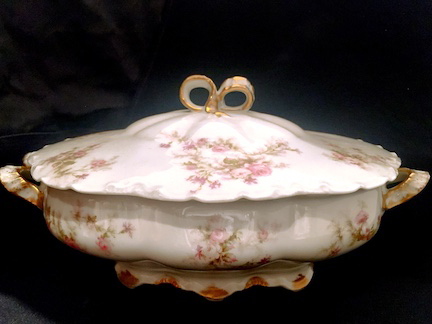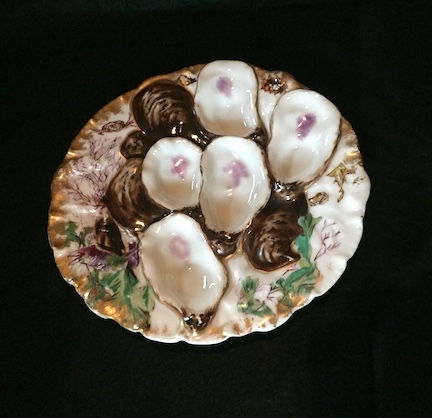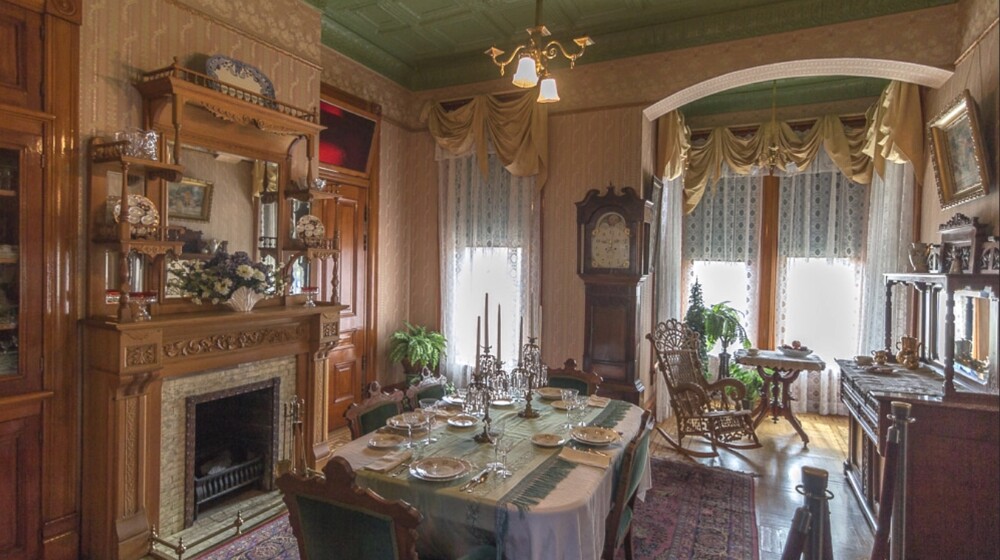Dining Room
More info about this room is coming soon!
There are a few interesting artifacts in this room that visitors want to know more about. Here are a few of our favorites, in alphabetical order (if there are any we’ve missed that you’d like to know more about, please let us know):
-
China Set
 Large set of Haviland cream china with small pink roses, circa 1900. Haviland was an American company that imported china from Limoges, France. The 1902 Sears and Roebuck catalog lists a full 100 piece set of Haviland china at a cost of $19.95 ($694 today, adjusted for inflation). It was the most expensive set in the catalog; the least expensive set was American made and cost $4.98 ($173.24 today, adjusted for inflation).
Large set of Haviland cream china with small pink roses, circa 1900. Haviland was an American company that imported china from Limoges, France. The 1902 Sears and Roebuck catalog lists a full 100 piece set of Haviland china at a cost of $19.95 ($694 today, adjusted for inflation). It was the most expensive set in the catalog; the least expensive set was American made and cost $4.98 ($173.24 today, adjusted for inflation). -
Cruet Set
 This cruet set is made by the Derby Silver Company (Derby, Connecticut), between 1872 and 1898. It’s a 6-bottle set that rotates, similar to a “Lazy Susan.” The cruet is very ornate and even includes a bell to call for service. The bottles are used for various food condiments – those with stoppers would often hold liquids like oil, vinegar, soy sauce or ketchup; and the bottles with shaker tops usually held salt, pepper, sugar or other dry seasonings. The shortest bottle is most likely a mustard pot.
This cruet set is made by the Derby Silver Company (Derby, Connecticut), between 1872 and 1898. It’s a 6-bottle set that rotates, similar to a “Lazy Susan.” The cruet is very ornate and even includes a bell to call for service. The bottles are used for various food condiments – those with stoppers would often hold liquids like oil, vinegar, soy sauce or ketchup; and the bottles with shaker tops usually held salt, pepper, sugar or other dry seasonings. The shortest bottle is most likely a mustard pot. -
Grandfather Clock
Tall, oak case clock, made by Richard Griffith from Denbigh, North Wales sometime between 1800-1830. The clock face is hand painted with a date tracker which has a sun, and a cathedral on the opposite side. The location of this clock was chosen because it is the same location that the Higley and Gammel families kept their grandfather clocks when they lived in the Rosson House.
-
Oyster Plates
 Pair of hand-painted oyster plates with five indentations for serving oysters, dated 1889 on the back. Oysters were abundant and inexpensive in the 19th century, which made them very much in demand. They were even popular in turn-of-the-century Phoenix, with two Oyster Parlors listed in the 1898 city directory, and oysters listed for sale at several grocery stores in the directory and in local newspapers.
Pair of hand-painted oyster plates with five indentations for serving oysters, dated 1889 on the back. Oysters were abundant and inexpensive in the 19th century, which made them very much in demand. They were even popular in turn-of-the-century Phoenix, with two Oyster Parlors listed in the 1898 city directory, and oysters listed for sale at several grocery stores in the directory and in local newspapers. -
Tilting Water Pitcher Set
Silver-plated set composed of a stand, pitcher, two goblets, and a drip pan. Instead of lifting to pour, the pitcher is balanced on the stand to easily tilt to pour and is insulated to keep water cool. Stamped on base “Rogers, Smith & Co./Meriden CT/Quadruple/Patd June 13, 1868, Pat Nov 30 1868/33”.
Discover what food was available in Phoenix at the turn-of-the-century in our blog articles, Bon Appétit and Victorian Food. Learn about Victorian Era dishware in our article, Dishing It Up.
El Comedor
¡Pronto habrá más información sobre esta habitación!
Hay algunos artefactos interesantes en esta habitación de los cuales los visitantes quisieran saber más. Aquí están algunos de nuestros favoritos, en orden alfabético (si hay alguno que ha faltado del cual quisieras saber más, háznoslo saber):
-
Juego de Jarra de Agua Pendular
Conjunto plateado compuesto por un soporte, una jarra, dos copas y una bandeja de goteo. En lugar de levantar para verter, la jarra se equilibra en el soporte para inclinarla fácilmente para verter, y está aislada para mantener el agua helada. En su base está sellada con “Rogers, Smith & Co./Meriden CT/Quadruple/Patd Junio 13, 1868, Pat Nov 30 1868/33”.
-
Juego de Porcelana
 Juego grande de porcelana color crema con pequeñas rosas rosadas, de alrededor de 1900. Haviland era una compañía americana que importaba porcelana de Limoges, Francia. El catálogo de 1902 de Sears y Roebuck catalog muestra un juego completo de 100 piezas de porcelana Haviland con un costo de $19.95 ($694 de hoy, ajustado por inflación). Era el conjunto más caro del catálogo; el juego menos costoso era de origen americano y costaba $4.98 ($173.24 de hoy, ajustado por inflación).
Juego grande de porcelana color crema con pequeñas rosas rosadas, de alrededor de 1900. Haviland era una compañía americana que importaba porcelana de Limoges, Francia. El catálogo de 1902 de Sears y Roebuck catalog muestra un juego completo de 100 piezas de porcelana Haviland con un costo de $19.95 ($694 de hoy, ajustado por inflación). Era el conjunto más caro del catálogo; el juego menos costoso era de origen americano y costaba $4.98 ($173.24 de hoy, ajustado por inflación). -
Juego de Vinagreras
 Este juego de vinagreras fue fabricado por Derby Silver Company (Derby, Connecticut), entre 1872 y 1898. Es un juego de 6 botellas que gira, similar a un “Lazy Susan.” La vinagrera está muy ornamentada e incluso incluye una campana para llamar al servicio. Las botellas se utilizan para varios condimentos – aquellas con tapones suelen contener líquidos como aceite, vinagre, salsa de soya o cátsup; las botellas con tapas agitadoras generalmente contenían sal, pimienta, azúcar u otros condimentos secos. La botella más pequeña es probablemente un recipiente para mostaza.
Este juego de vinagreras fue fabricado por Derby Silver Company (Derby, Connecticut), entre 1872 y 1898. Es un juego de 6 botellas que gira, similar a un “Lazy Susan.” La vinagrera está muy ornamentada e incluso incluye una campana para llamar al servicio. Las botellas se utilizan para varios condimentos – aquellas con tapones suelen contener líquidos como aceite, vinagre, salsa de soya o cátsup; las botellas con tapas agitadoras generalmente contenían sal, pimienta, azúcar u otros condimentos secos. La botella más pequeña es probablemente un recipiente para mostaza. -
Platos de Ostras
 Par de platos para ostras pintados a mano con cinco hendiduras para servir ostras, con fecha de 1889 en la parte posterior. Las ostras eran abundantes y baratas en el siglo XIX, lo cual las hizo muy solicitadas. Incluso eran populares en Phoenix a principios de siglo, con dos Salones de Ostras registrados en el directorio de la ciudad de 1898, y se anunciaban ostras en venta en varias tiendas de alimentos y en periódicos locales.
Par de platos para ostras pintados a mano con cinco hendiduras para servir ostras, con fecha de 1889 en la parte posterior. Las ostras eran abundantes y baratas en el siglo XIX, lo cual las hizo muy solicitadas. Incluso eran populares en Phoenix a principios de siglo, con dos Salones de Ostras registrados en el directorio de la ciudad de 1898, y se anunciaban ostras en venta en varias tiendas de alimentos y en periódicos locales. -
Reloj de Pie
Reloj alto con caja de roble, fabricado por Richard Griffith de Denbigh, North Wales entre 1800-1830. La cara del reloj está pintada a mano con un rastreador de fecha que tiene un sol y una catedral en el lado opuesto. La ubicación de este reloj fue elegida al ser la misma ubicación en donde las familias Higley y Gammel tenían su reloj de pie mientras vivieron en la Casa Rosson.
Descubre qué alimentos estaban disponibles en Phoenix al principio del siglo en nuestos artículos, Bon Appétit y Comida Victoriana. Aprende acerca de las vajillas victorianas en nuestro artículo, Dishing It Up (Sirviéndolo).
